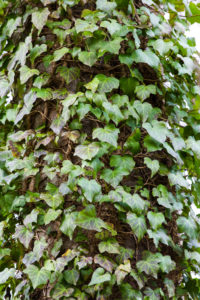Combating English ivy in the Old Forest
 A good rule of thumb: if something is green right now in the Old Forest, it’s probably an invasive species. Another good rule of thumb: it’s a good time of year to work on controlling those invasive species, because the native plants are dormant or have gone to seed and pollinators are less active. This means that chemical treatment options have less of an effect on the plants and wildlife that actually belong in the ecosystem.
A good rule of thumb: if something is green right now in the Old Forest, it’s probably an invasive species. Another good rule of thumb: it’s a good time of year to work on controlling those invasive species, because the native plants are dormant or have gone to seed and pollinators are less active. This means that chemical treatment options have less of an effect on the plants and wildlife that actually belong in the ecosystem.
That’s why this week, we’re continuing our efforts to combat invasive plant species in the Old Forest. Crews from Invasive Plant Control, a Nashville-based team of experts that works on projects around the country, will be in Overton Park this Thursday and Friday to treat invasive English ivy. They’ll apply a chemical that will travel through the plant and inhibit its energy production, so that hopefully we will start to see some dieback in the springtime. Their work will mainly be focused in the northern part of the forest, in a large patch of ivy along the Green Trail.
English ivy is a vine that was imported from Europe to serve as a low-maintenance residential groundcover that stays green all year long. It aggressively invades parks, forests, and fields, threatening native plants from the forest floor all the way up to the canopy. In addition to blanketing the ground and shading out wildflowers, English ivy climbs up tree trunks and wraps around branches, preventing trees from performing photosynthesis.
Several years ago, Conservancy staff conducted an experiment with controlling English ivy in this section of the forest. We created several different combinations of chemicals and surfactants (soapy substances that help the chemicals break through ivy’s waxy coating), dividing the ivy patch into nearly 100 plots. The most successful treatment, involving glyphosate, is the one Invasive Plant Control will be using this week.
You may temporarily see some blue dye on the ivy plants that have been sprayed; this is to help crews keep track of where they’ve been so that they don’t apply the chemicals to the same area twice. It should wash away shortly.
This work to restore our native ecosystem is only possible because of the support of people like you! Without intervention to control aggressive invaders like English ivy, kudzu, and Chinese privet, the Old Forest quickly becomes covered in these non-native plants, which crowd out plants that are local to the area and beneficial to our native mammals, birds, and insects. Your gift to Overton Park Conservancy directly supports this work, so please consider making a year-end donation to help us protect the Old Forest.



